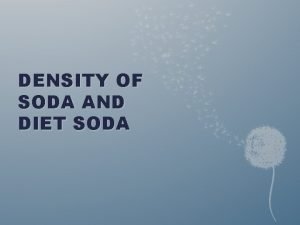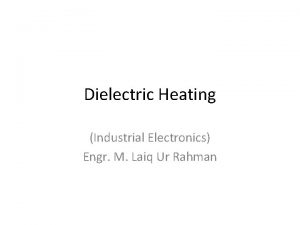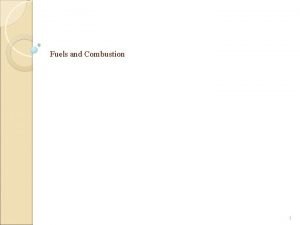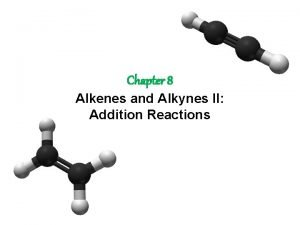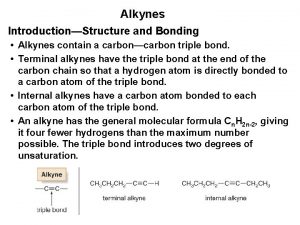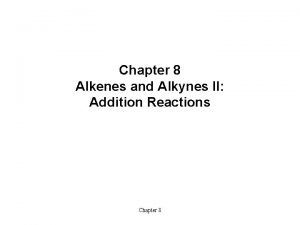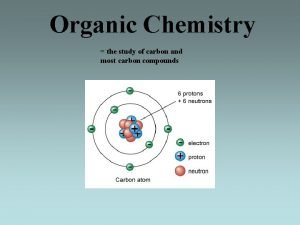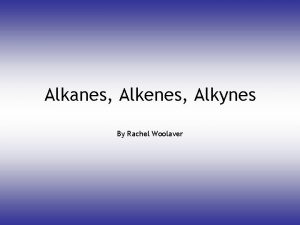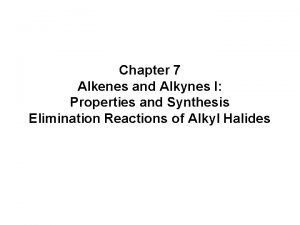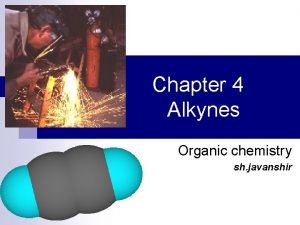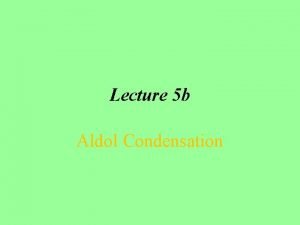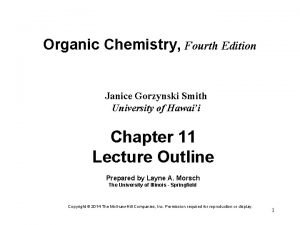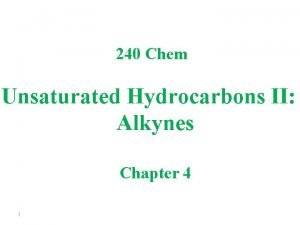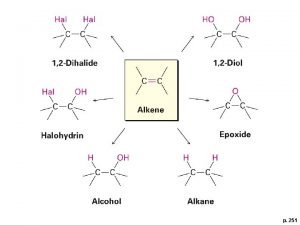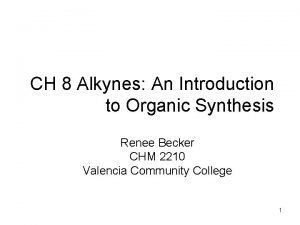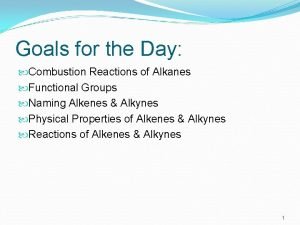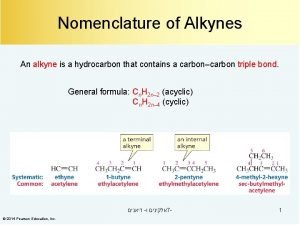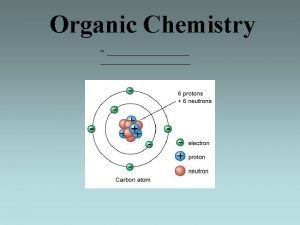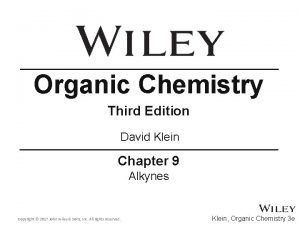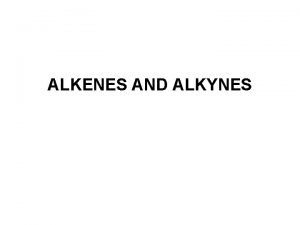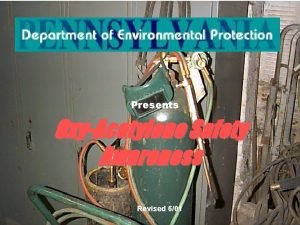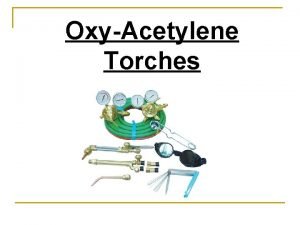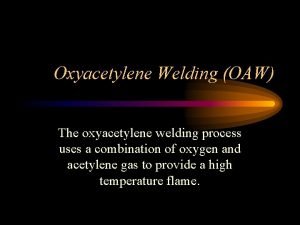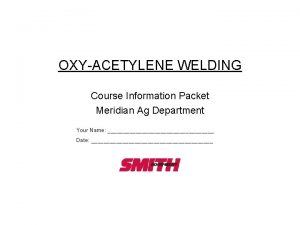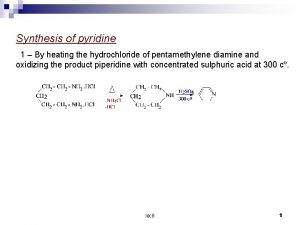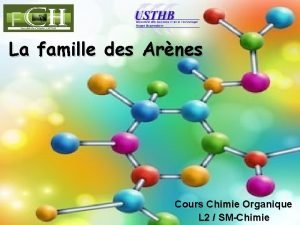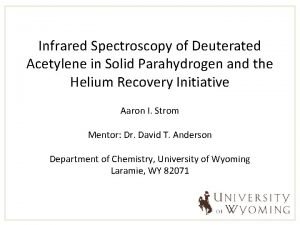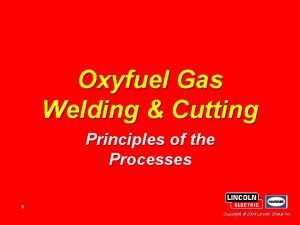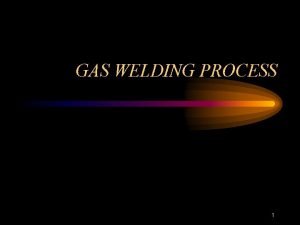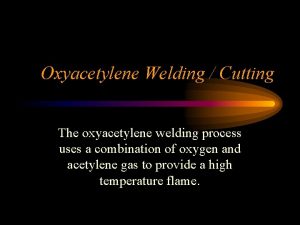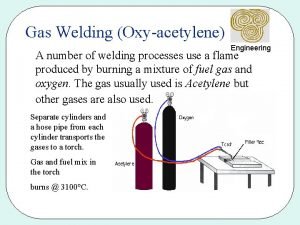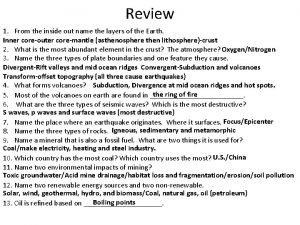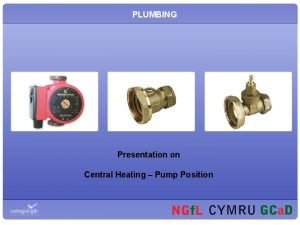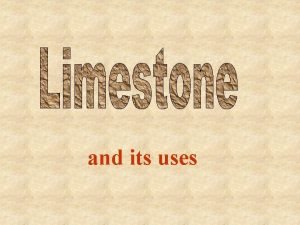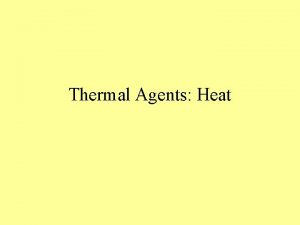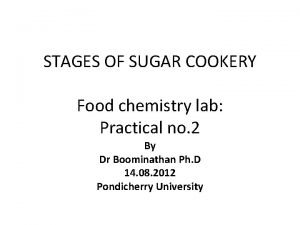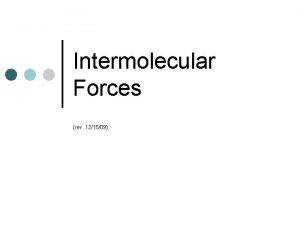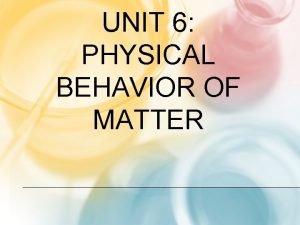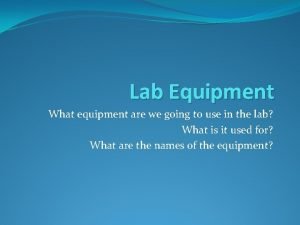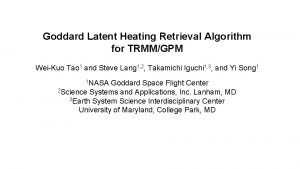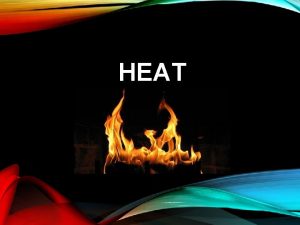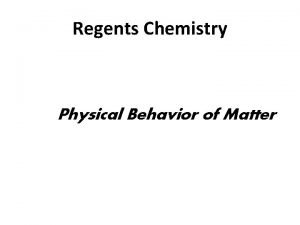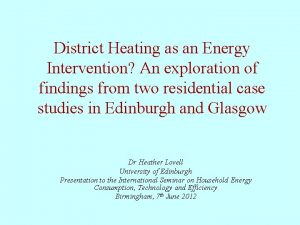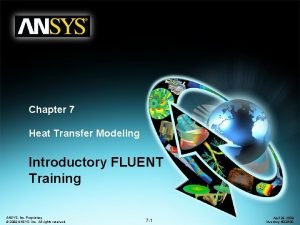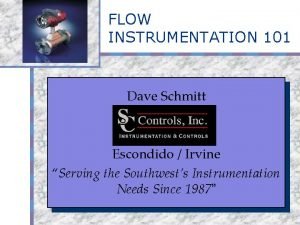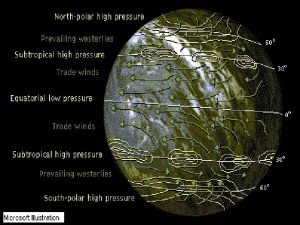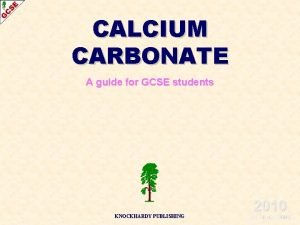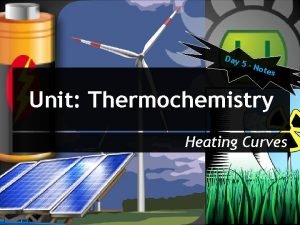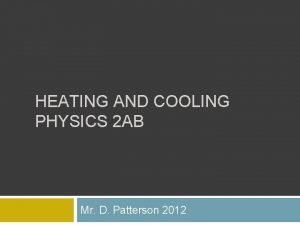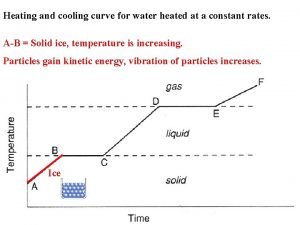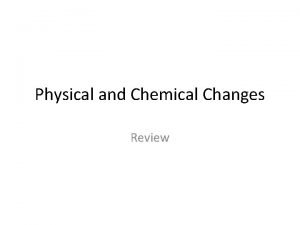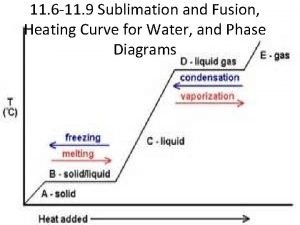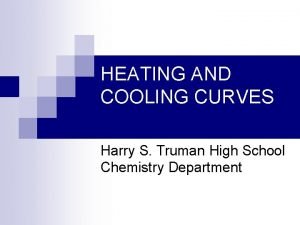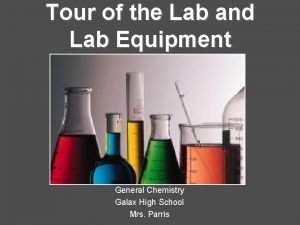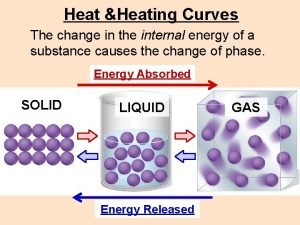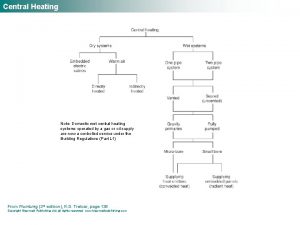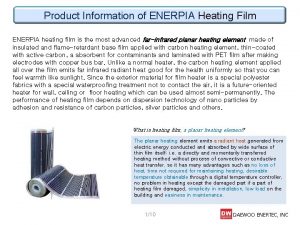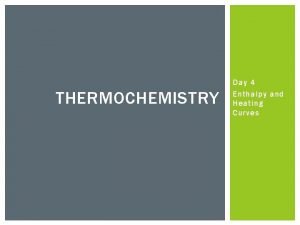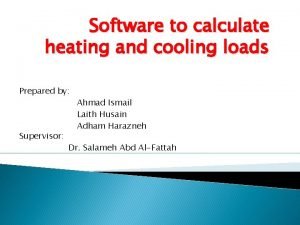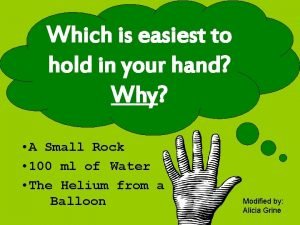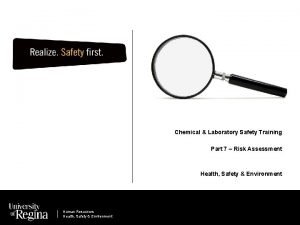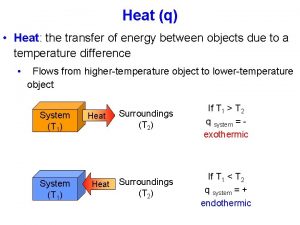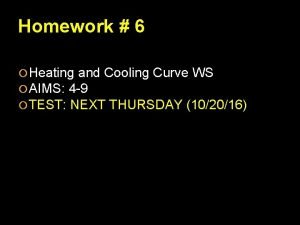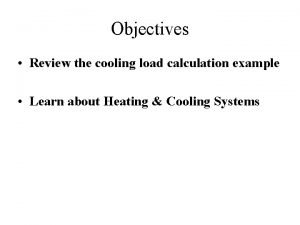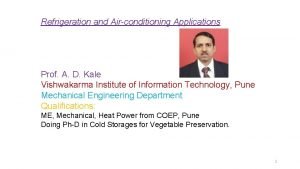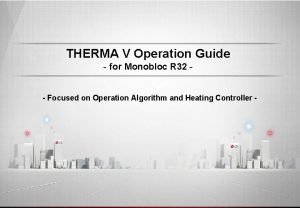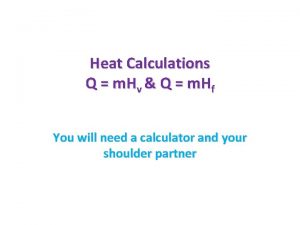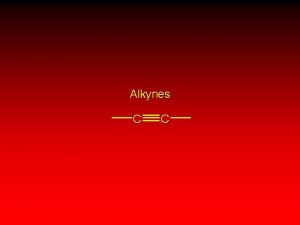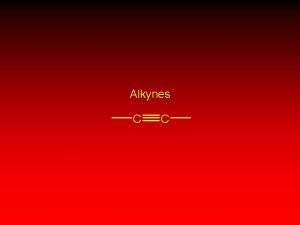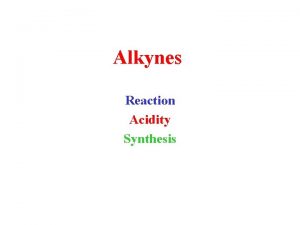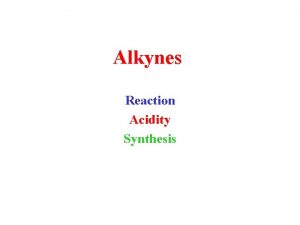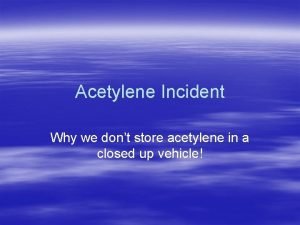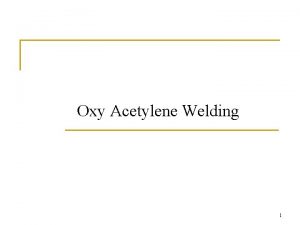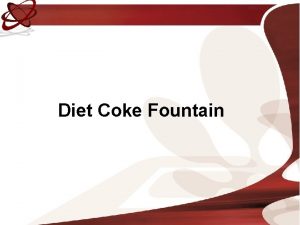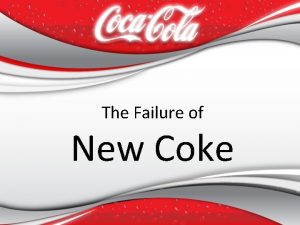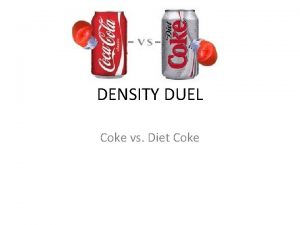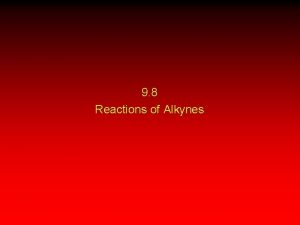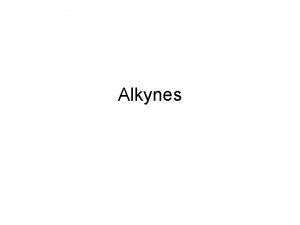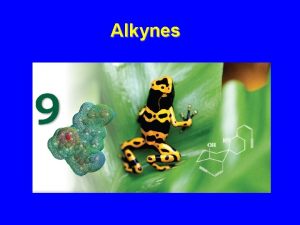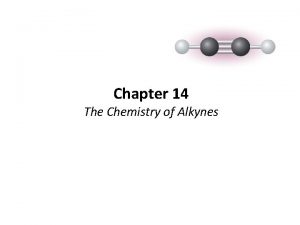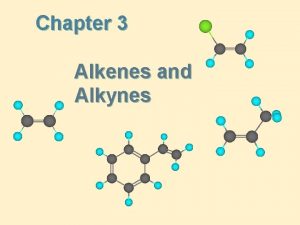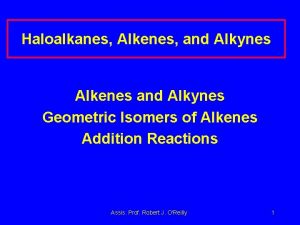Alkynes C C Synthesis of Acetylene Heating coke






























































































- Slides: 94

Alkynes C C

Synthesis of Acetylene Heating coke with lime in an electric furnace to forms calcium carbide. Then drip water on the calcium carbide. coke lime * *This reaction was used to produce light for miners’ lamps and for the stage.

The Structure of Alkynes A triple bond is composed of a s bond and two p bonds

Question Arrange ethane, ethene, and ethyne in order of increasing C-C bond length. A) ethane < ethene < ethyne B) ethene < ethane < ethyne C) ethyne < ethene < ethane D) ethane < ethyne < ethene

Acidity of Acetylene and Terminal Alkynes H C C

Acidity of Hydrocarbons In general, hydrocarbons are very weak acids Compound p. Ka HF 3. 2 H 2 O 16 NH 3 36 H 2 C CH 2 45 CH 4 60

Acetylene is a weak acid, but not nearly as weak as alkanes or alkenes. Compound p. Ka HF HC 3. 2 H 2 O 16 CH NH 3 36 H 2 C CH 2 45 CH 4 60 26

Question Which one of the following is the strongest acid? A) water B) ammonia C) 1 -butene D) 1 -butyne


Carbon: Hybridization and Electronegativity C 10 -60 H H C C H 10 -45 H+ + C C 10 -26 H+ + C : sp 3 : sp 2 C C : sp Electrons in an orbital with more s character are closer to the nucleus and more strongly held.

Question Which one of the following statements best explains the greater acidity of terminal alkynes (RCºCH) compared with monosubstituted alkenes (RCH=CH 2)? A) The sp-hybridized carbons of the alkyne are less electronegative than the sp 2 carbons of the alkene. B) The two p bonds of the alkyne are better able to stabilize the negative charge of the anion by resonance. C) The sp-hybridized carbons of the alkyne are more electronegative than the sp 2 carbons of the alkene. D) The question is incorrect - alkenes are more acidic than alkynes.

The stronger the acid, the weaker its conjugate base top 252

Sodium Acetylide Solution: Use a stronger base. Sodium amide is a stronger base than sodium hydroxide. Na. NH 2 + HC CH Na. C CH + NH 3. . – H 2 N : + H C CH stronger acid p. Ka = 26 . . H 2 N – H + : C weaker acid p. Ka = 36 Ammonia is a weaker acid than acetylene. The position of equilibrium lies to the right. CH

Question Which of the following bases is strong enough to completely deprotonate propyne? A) NH 3 B) CH 3 OH C) Na. NH 2 D) Na. OH

Preparation of Various Alkynes by alkylation reactions with Acetylide or Terminal Alkynes

Synthesis Using Acetylide Ions: Formation of C–C Bond

Alkylation of Acetylene and Terminal Alkynes H—C C—H R—C C—R

Alkylation of Acetylene and Terminal Alkynes H—C – C: + R X S N 2 H—C C—R + : X– The alkylating agent is an alkyl halide, and the reaction is nucleophilic substitution. The nucleophile is sodium acetylide or the sodium salt of a terminal (monosubstituted) alkyne.

Example: Alkylation of Acetylene HC CH Na. NH 2 HC NH 3 CNa CH 3 CH 2 CH 2 Br HC C CH 2 CH 2 CH 3 (70 -77%)

Question Which alkyl halide will react faster with the acetylide ion (HCºCNa) in an SN 2 reaction? A) bromopropane B) 2 -bromopropane C) tert-butyl iodide D) 1 -bromo-2 -methylbutane

Example: Alkylation of a Terminal Alkyne (CH 3)2 CHCH 2 C CH Na. NH 2, NH 3 (CH 3)2 CHCH 2 C CNa CH 3 Br (CH 3)2 CHCH 2 C (81%) C—CH 3

Example: Dialkylation of Acetylene H—C C—H 1. Na. NH 2, NH 3 2. CH 3 CH 2 Br CH 3 CH 2—C C—H 1. Na. NH 2, NH 3 2. CH 3 Br CH 3 CH 2—C C—CH 3 (81%)

Limitation Effective only with primary alkyl halides Secondary and tertiary alkyl halides undergo elimination

Acetylide Ion as a Base E 2 predominates over SN 2 when alkyl halide is secondary or tertiary. H—C – C: H C C X E 2 H—C C —H + C C + : X–

Question Consider the reaction of each of the following with cyclohexyl bromide. For which one is the ratio of substitution to elimination highest? A) Na. OCH 2 CH 3, ethanol, 60°C B) Na. SCH 2 CH 3, ethanol-water, 25°C C) Na. NH 2, NH 3, -33°C D) Na. CºCH, NH 3, -33°C

Preparation of Alkynes by Elimination Reactions

Preparation of Alkynes by "Double Dehydrohalogenation" H X H H C C H X X X Geminal dihalide Vicinal dihalide The most frequent applications are in preparation of terminal alkynes.

Geminal dihalide Alkyne (CH 3)3 CCH 2—CHCl 2 1. 3 Na. NH 2, NH 3 2. H 2 O (CH 3)3 CC CH (56 -60%)

Geminal dihalide Alkyne (CH 3)3 CCH 2—CHCl 2 (CH 3)3 CCH (CH 3)3 CC CHCl CH H 2 O (CH 3)3 CC Na. NH 2, NH 3 (slow) CNa Na. NH 2, NH 3 (slow) Na. NH 2, NH 3 (fast)

Question In addition to Na. NH 2, what other base can be used to convert 1, 1 -dichlorobutane into 1 -butyne? A) Na. OCH 3 B) Na. OH C) Na. OCH 2 CH 3 D) KOC(CH 3)3

Vicinal dihalide Alkyne CH 3(CH 2)7 CH—CH 2 Br Br 1. 3 Na. NH 2, NH 3 2. H 2 O CH 3(CH 2)7 C (54%) CH

Question Which of the following compounds yield 1 heptyne on being treated with three moles of sodium amide (in liquid ammonia as the solvent) followed by adding water to the reaction mixture? A) 1, 1, 2, 2 -tetrachloroheptane B) 1 -bromo-2 -chloroheptane C) 1, 1, 2 -trichloropentane D) all of the above

Reactions of Alkynes

Reactions of Alkynes Acidity Hydrogenation Metal-Ammonia Reduction Addition of Hydrogen Halides Hydration Addition of Halogens Ozonolysis

Hydrogenation of Alkynes

Atomic Force Microscopy of Acetylene Lawrence Berkeley Laboratory (LBL) H C C H

Imaging: acetylene on Pd(111) at 28 K Molecular Image Tip cruising altitude ~700 pm Δz = 20 pm H C C H Why don’t we see the Pd atoms? Because the tip needs to be very close to image the Pd atoms and would knock the molecule away Surface atomic profile Tip cruising altitude ~500 pm Δz = 2 pm TIP pz H + O p orbital Calculated image (Philippe Sautet) If the tip was made as big as an airplane, it would be flying at 1 cm from the surface and waving up an down by 1 micrometer The STM image is a map of the pi-orbital of distorted acetylene M. Salmeron (LBL) 1 cm (± 1 μm)

Excitation of frustrated rotational modes in acetylene molecules on Pd(111) at T = 30 K Tip e- ((( ) ( ))) M. Salmeron (LBL)

Hydrogenation of Alkynes RC CR' + 2 H 2 cat RCH 2 R' catalyst = Pt, Pd, Ni, or Rh alkene is an intermediate

Partial Hydrogenation RC CR' H 2 cat RCH CHR' H 2 cat RCH 2 R' Alkenes could be used to prepare alkenes if a catalyst were available that is active enough to catalyze the hydrogenation of alkynes, but not active enough for the hydrogenation of alkenes.

Lindlar Palladium RC CR' H 2 cat RCH CHR' H 2 cat RCH 2 R' There is a catalyst that will catalyze the hydrogenation of alkynes to alkenes, but not that of alkenes to alkanes. It is called the Lindlar catalyst and consists of palladium supported on Ca. CO 3, which has been poisoned with lead acetate and quinoline. syn-Hydrogenation occurs; cis alkenes are formed.

Example CH 3(CH 2)3 C C(CH 2)3 CH 3 + H 2 Lindlar Pd CH 3(CH 2)3 CH 3 C C H H (87%)



Metal-Ammonia Reduction of Alkynes trans-Alkenes

Partial Reduction RC CR' RCH CHR' RCH 2 R' Another way to convert alkynes to alkenes is by reduction with sodium (or lithium or potassium) in ammonia. trans-Alkenes are formed.


Example CH 3 CH 2 C CCH 2 CH 3 Na, NH 3 CH 3 CH 2 H C C CH 2 CH 3 H (82%)


Question How would you accomplish the following conversion? A) B) C) D) Na. NH 2 H 2, Lindlar Pd Na, NH 3 either B or C

Mechanism Metal (Li, Na, K) is reducing agent; H 2 is not involved; proton comes from NH 3 four steps (1) electron transfer (2) proton transfer (3) electron transfer (4) proton transfer

Question Select the most effective way to synthesize cis-2 -pentene from 1 -propyne. A) 1) Na. NH 2 2) CH 3 CH 2 Br 3) H 2, Pd B) 1) Na. NH 2 2) CH 3 Br 3) H 2, Lindlar Pd C) 1) Na. NH 2 2) CH 3 CH 2 I 3) H 2, Lindlar Pd D) 1) Na. NH 2 2) CH 3 CH 2 Br 3) Na, NH 3

Answer Select the most effective way to synthesize cis-2 -pentene from 1 -propyne. A) 1) Na. NH 2 2) CH 3 CH 2 Br 3) H 2, Pd B) 1) Na. NH 2 2) CH 3 Br 3) H 2, Lindlar Pd C) 1) Na. NH 2 2) CH 3 CH 2 I 3) H 2, Lindlar Pd D) 1) Na. NH 2 2) CH 3 CH 2 Br 3) Na, NH 3

Question Which reagent would accomplish the transformation of 3 -hexyne into trans-3 hexene? A) H 2/Ni B) H 2, Lindlar Pd C) Na, NH 3 D) Na. NH 2, NH 3

Answer Which reagent would accomplish the transformation of 3 -hexyne into trans-3 hexene? A) H 2/Ni B) H 2, Lindlar Pd C) Na, NH 3 D) Na. NH 2, NH 3

Problem Suggest an efficient syntheses of (E)- and (Z)-2 heptene from propyne and any necessary organic or inorganic reagents.

Problem Strategy

Problem Strategy

Problem Synthesis 1. Na. NH 2 2. CH 3 CH 2 CH 2 Br H 2, Lindlar Pd Na, NH 3

Question Which would be the best sequence of reactions to use in order to prepare cis-3 -nonene from 1 -butyne? A) 1. Na. NH 2 in NH 3; 2. 1 -bromopentane; 3. H 2, Lindlar Pd B) 1. Na. NH 2 in NH 3; 2. 1 -bromopentane; 3. Na, NH 3 C) 1. H 2, Lindlar Pd; 2. Na. NH 2 in NH 3; 3. 1 bromopentane D) 1. Na, NH 3; 2. Na. NH 2 in NH 3; 3. 1 bromopentane

Addition of Hydrogen Halides to Alkynes

Follows Markovnikov's Rule CH 3(CH 2)3 C CH HBr CH 3(CH 2)3 C CH 2 Br (60%) Alkynes are slightly less reactive than alkenes

Two Molar Equivalents of Hydrogen Halide CH 3 CH 2 C CCH 2 CH 3 2 HF CH 3 CH 2 H F C C H F (76%) CH 2 CH 3

Free-radical Addition of HBr CH 3(CH 2)3 C CH HBr peroxides CH 3(CH 2)3 CH (79%) regioselectivity opposite to Markovnikov's rule CHBr


Hydration of Alkynes expected reaction: RC CR' + H 2 O H+ RCH CR' OH enol observed reaction: RC CR' + H 2 O H+ RCH 2 CR' O ketone

Enols RCH CR' OH enol RCH 2 CR' O ketone enols are regioisomers of ketones, and exist in equilibrium with them keto-enol equilibration is rapid in acidic media ketones are more stable than enols and predominate at equilibrium


Mechanism of conversion of enol to ketone . . : O H + : O H C H

Mechanism of conversion of enol to ketone . . : O H + : O H C H

Mechanism of conversion of enol to ketone . . : O H : O: H H C C + H

Mechanism of conversion of enol to ketone H. . : O H C C + H : O: H

Key Carbocation Intermediate Carbocation is stabilized by electron delocalization (resonance). . . : O H C C + . . +O H H C C H

Mechanism of conversion of enol to ketone H. . : O H C C + H : O: H

Useful for symmetrical starting alkynes to produce a single product. Unsymmetrical starting alkynes that are not terminal produce a mixture of ketones…non-regioselectively.

Regioselectivity Markovnikov's rule followed in formation of enol, Useful with terminal alkynes. O H 2 O, H 2 SO 4 CH 3(CH 2)5 C CH CH 3(CH 2)5 CCH 3 Hg. SO 4 (91%) via OH CH 3(CH 2)5 C CH 2

Aldehyde vs. Ketone

Question What is the product of the acid catalyzed hydration of 1 -hexyne? A) B) C) D)

Addition of Halogens to Alkynes

Example Cl HC CCH 3 + 2 Cl 2 CH C CH 3 Cl (63%)

Addition is anti CH 3 CH 2 C CCH 2 CH 3 Br 2 Br CH 3 CH 2 C C CH 2 CH 3 Br (90%)

Ozonolysis of Alkynes gives two carboxylic acids by cleavage of triple bond

Example CH 3(CH 2)3 C CH 1. O 3 2. H 2 O O O CH 3(CH 2)3 COH (51%) + HOCOH

Question What product is formed when 2 -butyne is subjected to ozonolysis? A) B) C) D)

Alkynes Synthesis & Functions

Can you identify and name the function?





Example



Question What is the structure of Compound Y in the following synthetic sequence? A) B) C) D) pentane cis-2 -pentene trans-2 -pentene 2 -pentyne
 Coke vs diet coke density lab report
Coke vs diet coke density lab report Dielectric heating formula
Dielectric heating formula Was diet coke
Was diet coke Share a coke with lisa
Share a coke with lisa Coke is countable or uncountable
Coke is countable or uncountable Coke coffee
Coke coffee Otto hoffman's by product oven
Otto hoffman's by product oven Killer coke
Killer coke 4ps of pepsi
4ps of pepsi Lemonade countable or uncountable
Lemonade countable or uncountable Post colonial literature
Post colonial literature Holkham hall family
Holkham hall family Alkene reactions
Alkene reactions Alkynes
Alkynes Addition of hydrogen halides to alkynes
Addition of hydrogen halides to alkynes First 10 members of alkynes
First 10 members of alkynes Alkanes alkenes alkynes
Alkanes alkenes alkynes Alkynes
Alkynes Mercury catalyzed hydration of alkynes
Mercury catalyzed hydration of alkynes Aldol condensation
Aldol condensation Halogenation of alkynes
Halogenation of alkynes Hybridization of alkynes
Hybridization of alkynes Dihydroxylation
Dihydroxylation Mercury catalyzed hydration of alkynes
Mercury catalyzed hydration of alkynes Combustion of alkynes
Combustion of alkynes Lindlar pd
Lindlar pd Condensed structural formula of propyne
Condensed structural formula of propyne Alkyne to alkene
Alkyne to alkene General formula of alkene
General formula of alkene Oxygen acetylene ratio for brazing
Oxygen acetylene ratio for brazing Oxy-acetylene welding tip size chart
Oxy-acetylene welding tip size chart Ppe for oxy-acetylene welding
Ppe for oxy-acetylene welding Carburizing flame definition
Carburizing flame definition Acetylene cylinder cutaway
Acetylene cylinder cutaway Pentamethylene diamine hydrochloride
Pentamethylene diamine hydrochloride Trimerisation de l'acétylène
Trimerisation de l'acétylène Deuterated acetylene
Deuterated acetylene Acetylene cylinder cutaway
Acetylene cylinder cutaway Gas welding safety tips
Gas welding safety tips Oxy fuel welding definition
Oxy fuel welding definition Gas welding definition
Gas welding definition A regulator diaphragm is often made from ____
A regulator diaphragm is often made from ____ 29 cfr 1910 subpart q
29 cfr 1910 subpart q Acetylene flame temperature
Acetylene flame temperature Induction heating comsol
Induction heating comsol Answer the questions below regarding the heating of a house
Answer the questions below regarding the heating of a house Central heating pump position
Central heating pump position Limestone used for
Limestone used for Superficial and deep heating modalities
Superficial and deep heating modalities Sugar temperature stages
Sugar temperature stages Serc.carleton.edu
Serc.carleton.edu Physical behavior of matter heating and cooling curves
Physical behavior of matter heating and cooling curves Platform holds heating unit
Platform holds heating unit Evergreen plumbers
Evergreen plumbers Goddard heating and air
Goddard heating and air Heat curve
Heat curve Physical behavior of matter
Physical behavior of matter Wyndford estate glasgow district heating
Wyndford estate glasgow district heating Definition of vocabulary
Definition of vocabulary Radiation model in fluent
Radiation model in fluent Instrumentation 101
Instrumentation 101 Southeast trade winds
Southeast trade winds Calcium carbonate heat reaction
Calcium carbonate heat reaction Define heating curve
Define heating curve 6 phase changes
6 phase changes Dsqr training
Dsqr training Heating curve labeled
Heating curve labeled Induction heating
Induction heating Is charcoal heating a grill a physical or chemical change
Is charcoal heating a grill a physical or chemical change Sieb plumbing and heating
Sieb plumbing and heating Fusion sublimation
Fusion sublimation Heating and cooling curves
Heating and cooling curves Striker lab equipment
Striker lab equipment Heating curve
Heating curve Nanocad midpoint
Nanocad midpoint Ken brady
Ken brady Sea breeze
Sea breeze F&e heating system diagram
F&e heating system diagram Enerpia heating film
Enerpia heating film Label heating curve
Label heating curve One case of dehydrated milk
One case of dehydrated milk Estimating air conditioning load software
Estimating air conditioning load software Solid to heat
Solid to heat Termis district heating software
Termis district heating software Jon snow golden ratio
Jon snow golden ratio Kuas infrared panel
Kuas infrared panel H&c heating and cooling
H&c heating and cooling Heating mantle risk assessment
Heating mantle risk assessment Geothermal heating tuscarora
Geothermal heating tuscarora G/4
G/4 Heating curve homework
Heating curve homework Cooling load calculation sample problems
Cooling load calculation sample problems Kale heating and cooling
Kale heating and cooling Lg therma v ch14
Lg therma v ch14 Q=m∆h
Q=m∆h
